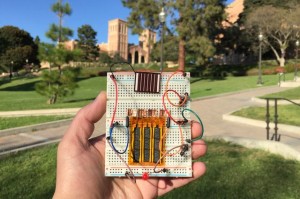
The hybrid supercapacitor can store large amounts of energy, recharge quickly, and last for more than 10,000 recharge cycles.
Image: UCLA
Researchers from UCLA’s California NanoSystems Institute (CNSI) have developed a new generation of supercapacitors that not only emphasizes the best inherent properties of the supercapacitor itself, but also combines it with some of the best qualities of batteries to make a new energy storage medium.
The new supercapacitor is paper-thin and has an extremely fast recharge time. Additionally, it can last more than 10,000 recharge cycles.
Researchers believe this new development will yield real-world potential to address energy issues and improve personal electronics.
“The microsupercapacitor is a new evolving configuration, a very small rechargeable power source with a much higher capacity than previous lithium thin-film microbatteries,” said Maher El-Kady, co-author of the study and postdoctoral scholar.
This from UCLA:
The new components combine laser-scribed graphene, or LSG — a material that can hold an electrical charge, is very conductive, and charges and recharges very quickly — with manganese dioxide, which is currently used in alkaline batteries because it holds a lot of charge and is cheap and plentiful. They can be fabricated without the need for extreme temperatures or the expensive “dry rooms” required to produce today’s supercapacitors.
Along with its potential in the field of energy storage, the team also believes that due to the device’s thin size, it can be utilized in wearables or inside medical implants.
“Let’s say you wanted to put a small amount of electrical current into an adhesive bandage for drug release or healing assistance technology,” said Richard Kaner, lead author and distinguished professor of chemistry and biochemistry and materials science and engineering.
“The microsupercapacitor is so thin you could put it inside the bandage to supply the current. You could also recharge it quickly and use it for a very long time.”
The findings were published in Proceedings of the National Academy of Sciences.
Want more info on supercapacitors? Check out our JES Focus Issue on Electrochemical Capacitors: Fundamentals to Applications!

